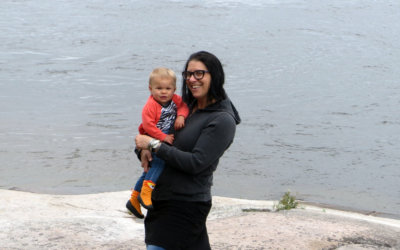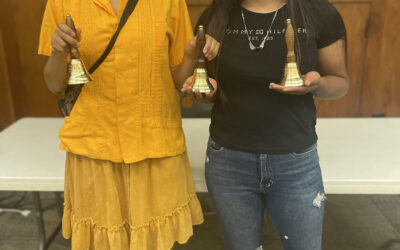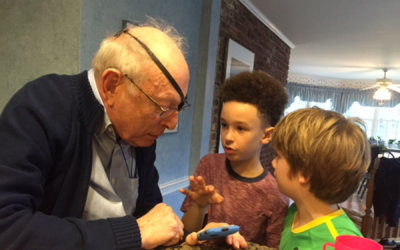The overall urban population of the world has grown from 751 million in 1950 to 4.2 billion in 2018 according to the United Nations Department of Economic and Social Affairs, while the rural population of the world has grown slowly since 1950 and is expected to peak soon. The UN reports current populations living in urban areas at: 82% in Northern America, 81% in Latin America and the Caribbean, 74% in Europe, 68% in Oceania, 50% in Asia, and 43% in Africa. The report also notes that while some cities have seen population decline, fewer cities are projected to see their populations decline from today until 2030, compared to what has occurred during the last two decades.
“We do not need to plan or devise a ‘world of the future;’ if we take care of the world of the present, the future will have received full justice from us.”
And recent news is alarming. A study by the United Nations’ Intergovernmental Panel on Climate Change (IPCC) says that the Paris Agreement—pledges from the world’s governments to reduce greenhouse gases, made in Paris in 2015—isn’t enough to keep global warming from rising more than 1.5 degrees Celsius (2.7 degrees F) above pre-industrial temperatures. According the the IPCC, limiting global warming to 1.5°C would require rapid, far-reaching, and unprecedented changes in all aspects of society.
These converging factors put cities on the frontlines of this climate change fight. Considering that city dwellers have smaller carbon footprints than national averages (according to a study by the International Institute for Environment and Development), cities have a critical role to play in creating solutions to climate change. In his book, Cities in Civilization, noted urbanist and historian Sir Peter Hall opines that “every great burst of creativity in human history” is an urban phenomenon (interesting to juxtapose this with Arthur Morgan’s hypothesis that small communities are “the lifeblood of civilization”). With rapidly growing urban populations and a plethora of complex issues facing cities and the world at large, can cities create that next great burst to produce a sustainable future?
It is important, however, to recognize that cities and urban conditions are not simply the organization of objects within a space or the relationships of density versus sprawl. Their economic, political, social, ecological, and structural realities are far more complex. Distinguished anthropologist and geographer David Harvey noted that, “Urbanism has to be regarded as a set of social relationships which reflects the relationships established throughout society a whole. Further, these relationships have to express the laws whereby urban phenomena are structured, regulated, and constructed.” It will require a compound and multidisciplinary effort for cities to answer the urgent need to live in the world more sustainably—with care for the wellbeing of the planet and its inhabitants— in order to address climate change.
Considering the complexities inherent in urban environments—even without the variable of sustainability—the prospects are daunting.
Many Antiochians have been engaged with addressing issues of sustainability at multiple levels and scales for decades. And all of these strategies are needed as part of creating solutions to grave challenges.
A TREE FOR MY SIDEWALK
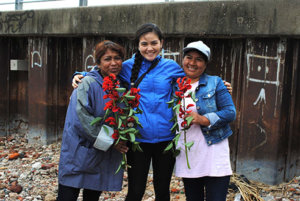
Michelle Fujii ’18 (center) at a tree planting event in November 2017 with Buenos Aires residents holding native Ciebo, the national flower from the national tree of Argentina.
One effective way to mitigate carbon dioxide emissions, as well as connect city residents with the life cycle of the living environment, is planting trees. With this in mind in 2012, a group of people sought to fill vacant treewells in the sidewalks of Buenos Aires, Argentina, and to encourage residents to gain a sense of ownership for their environment. The group grew into a nonprofit, Un Arbol Para Mi Vereda (A Tree for My Sidewalk), which is now involved with a wide variety of community-based environmental projects including helping maintain food producing gardens in schools and neighborhoods, helping businesses with composting programs, and organizing tree-planting events. Michelle Fujii ’18 Co-oped with the organization and participated in their year-long undertaking with the city’s Agencia de Protección Ambiental (APrA or Environmental Protection Agency) to cultivate 8,000 trees. Eventually the APrA plans to cultivate 20,000 trees every year to plant in the city.
“This project was particularly interesting for me because it combined many of my interests from socio-economic issues to relations between non-governmental organizations and governmental institutions,” explains Fujii. “Buenos Aires has many environmental issues just like other large cities around the world. Citizens are concerned about water quality, contaminated rivers, air pollution, waste, access to healthy food, and poverty. I think urban green spaces and the urban garden movement act as a unique catalyst to incite dialogue around climate change and environmental issues because of how visible they are compared to other environmental concerns.”
Fujii is now living in New York City where she continues to explore ecological movements and urban planning.
NET ZERO BUILDINGS
When it comes to structures, Sara Rothholz Weiner ’79 says, “Net Zero buildings that are self-sustaining and generative is the wave of both the present and our future.”
Rothholz Weiner is a community advocate, personally and professionally. She is a LEED-credentialed registered architect currently working at Gensler (one of the largest and notable design firms in the world) and has taught at the University of Minnesota’s College of Architecture and Landscape Architecture.
Rothholz Weiner focused on Communications and Art at Antioch (“Bob Devine ’67 completely shook my world view,” she adds) and worked at the Whitney Museum of American Art after graduation in the Film and Video Department. “I later connected the dots of many of my interests and found architecture provided me with a blend of technology, research, aesthetics, art, public policy, and culture that was a perfect fit for me and did another undergraduate and a graduate degree in Architecture.”
“The power of sustainable design and architecture is to create meaning and to positively impact people’s lives and create a better world. Sustainability touches on ecology, materials, stewardship, water, energy, culture and community and it propels us to be resourceful, resilient, and innovative,” she explains.
Beyond the professions, she sees small organizations, start ups, and “scrappy groups of people who just care” as important in creating a sustainable future.
COASTAL ADAPTATION
“Climate change is just one of many environmental considerations being discussed as part of our latest Plan of Conservation & Development,” says Dorothy S. Wilson ’76, Senior Planner at the City of Norwalk, CT. “Other environmental concerns include improving air quality, preventing future water shortages, improving the water quality of runoff to protect our harbor, providing increased access to parks and green space, and encouraging the use of green design features in new development (such as porous pavement, green roofs, etc.).”

Dorothy S. Wilson ’76
Walkability and access to regional mass transit links are also priorities for the city, which has formed a new Bike Walk Commission to seek investment in the city’s pedestrian and bicycling network and infrastructure. And, Norwalk has joined a new initiative of the State of Connecticut’s Department of Energy and Environmental Protection, which has the goal to support regional collaboration on a broad range of actions including improving watershed management, implementation of “complete streets,” reducing energy use and increasing renewable energy, and assessing climate vulnerability. “The regional approach will ensure a more effective response to addressing issues of mutual concerns.”
The historic coastal city is addressing issues related to rising seawater and revamped its flood zone regulations following Superstorm Sandy in 2012. “The most effective way is to use alternative stormwater structures to better control the impact of flooding and to encourage the proliferation of more flood-resistant designs for future developments,” she explains. “This will promote new flood-safe buildings and ensure the preservation of existing historic buildings key to the fabric of our community.”
A MOVEMENT
Two winters on AEA in Guanajuato, Mexico, were formative in how Robert Davis ’65 came to understand what a sustainable urban environment could look like. He says Guanajuato “really opened my eyes to the notion of very dense very compact walkable urbanism. And how wonderful small town life could be…” This experience later inspired his career and involvement in The New Urbanism, a movement in land planning which is helping to revolutionize town planning in America.
Both Davis and fellow Antiochian Peter Calthorpe ’72 were among the original founders of The Congress for The New Urbanism (CNU) in response to the decline of cities. “We decided that if you were really going to make change, you have to create a movement,” says Calthorpe. “And if you wanted to create a movement, you create something that people can be clear about what it stands for.”
The Charter of the New Urbanism lays out the values of the movement, and opens with this statement:
The Congress for the New Urbanism views disinvestment in central cities, the spread of placeless sprawl, increasing separation by race and income, environmental deterioration, loss of agricultural lands and wilderness, and the erosion of society’s built heritage as one interrelated community-building challenge.
The Charter goes on to layout core principles. “It really excited a lot of people because it was just so powerful and clear,” says Calthorpe.
Robert Davis founded Seaside, a community on the Florida panhandle envisioned in 1985 and widely considered to be the birthplace of The New Urbanism. He is also a principal in The Arcadia Land Company, a firm specializing in town building and land stewardship. He has also served on Florida’s Environmental Land Management Study Committee, writing and updating Florida’s growth management legislation, on The Governor’s Council for Sustainable Florida, on The Trust for Public Land’s Real Estate Advisory Board, and continues to be involved with CNU policy issues.
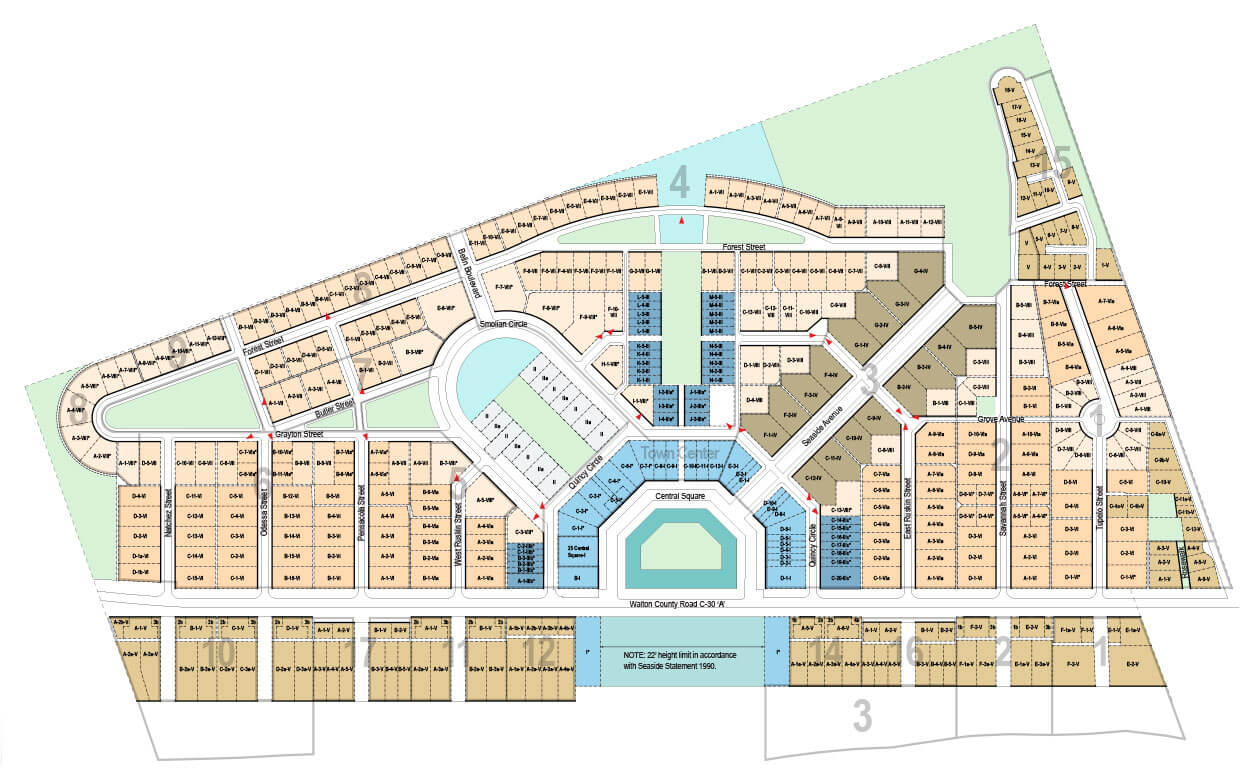
Time magazine said Seaside “could be the most astounding design achievement of its era.” The community modeled a pattern of sustainable development which had been written off by builders and developers, and proved walkable communities were viable in the market. Seaside also employed green infrastructure for stormwater management, an emphasis on the use of native vegetation, and preservation of sand dunes to provide protection from storms.
Before real estate, Davis worked at Huston-Tillotson College and at Antioch College. “I had absolutely no qualifications other than a Harvard MBA to take a job in the real estate business,” he says. “I finally found somebody who figured I must be a quick study and I could learn about a very obscure part of the real estate business that they didn’t know at Housing Corporation of America.”
He worked in D.C. where he studied with some experts on the FHA 236 program which subsidized low income housing by reducing the interest rates on loans. Wealthy investors took advantage of the guarantees and huge tax incentives, investing in what Davis says were “instant slums” and that taxpayers were footing the bill to underwrite the program. One of the results was also a shameful legacy of socio-economic segregation and the of perpetuation of sprawl. “I finally determined that was a stupid way to house poor people and that we would be much better off following Milton Friedman’s advice and giving them vouchers to find their own housing,” Davis explains.
Rather than sprawl (both urban and suburban) and the segregation of uses and socio- economic groups, The New Urbanism promotes vibrant and walkable cities, towns, and neighborhoods where people have diverse choices for how they live and work.
“The most important thing that the New Urbanism can do for the environment is get people out of cars. Get them to walk. It’s healthier for them, doesn’t consume petrochemicals, and doesn’t put carbon into the air,” says Davis. “The other things that we engaged in at Seaside are fairly common in the movement. And that’s really paying attention to the ways that buildings work with the climate rather than having to be heated and air conditioned all the time, and insulated and sealed up to isolate people.”
SYSTEMS THINKING
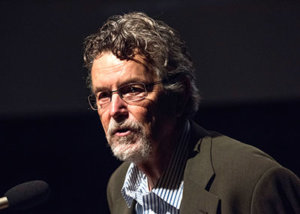
Peter Calthorpe ’72
Architect and urban designer Peter Calthorpe ’72 is a leader in The New Urbanism movement and has been one of the leading thinkers in the field of sustainable urbanism for decades.
In a talk given at the official TED conference in April 2017, Calthorpe notes, “At the same time that we’re solving for climate change, we’re going to be building cities for three billion people. That’s a doubling of the urban environment. If we don’t get that right, I’m not sure all the climate solutions in the world will save mankind, because so much depends on how we shape our cities: not just environmental impacts, but our social wellbeing, our economic vitality, our sense of community and connectedness. Fundamentally, the way we shape cities is a manifestation of the kind of humanity we bring to bear. And so getting it right is, I think, the order of the day. And to a certain degree, getting it right can help us solve climate change, because in the end, it’s our behavior that seems to be driving the problem. The problem isn’t free-floating, and it isn’t just ExxonMobil and oil companies. It’s us; how we live.”
Calthorpe has been involved in issues of human sustenance and urbanism since his Co-op at Pacific High School in California from which he never returned. He was fascinated by the systems thinking of Buckminster
Fuller, recognizing the complex web of issues related to living sustainably at a time when environmental concerns hadn’t reached the national or global consciousness. Intrigued about how built environments could respond to the complex issues facing humanity, Calthorpe decided to attend the Yale School of Architecture, admitted to the graduate program despite not completing his bachelor’s degree at Antioch College. But, he dropped out, this time out of frustration over the narrow thinking of the architectural program which he didn’t feel truly recognized the complexity of the built environment. He says the students were “just thinking about building a sculpture as opposed to environmental and social interface that they truly are.”
It was his Co-op experience where he was involved with the creation of Pacific High School’s residential community centered on a then-new vision of sustainability (“It was much cooler to be a place that was doing it than just thinking about it,” he says), along with the influence of Fuller, was pivotal in the creation of a deeply held ethos for Calthorpe which set him on a path to become involved in passive solar building and then to urban design and community planning. “What really struck me about Fuller’s ideas was his whole systems thinking … the idea that you had to look at life-cycle efficiencies and you had to look at resource efficiencies. You couldn’t just look at things from an engineering standpoint, but you had to look at where the energy and materials came from and where they went to, afterwards, and how much it costs to maintain it.”
Calthorpe saw the larger built environment as his challenge to address. “I got very focused on communities and I got very focused on transit. It became clear to me that the car was one of the greatest transgressions to the environment and to the the health of communities. And, sprawl, the isolation of uses and the isolation of different people and income groups, and the fact that kids became stranded. Every dimension that you can think of gets impacted by a culture built around the car.” In his 1993 book, The Next American Metropolis: Ecology, Community, and the American Dream, Calthorpe introduced the now widely adopted concept of Transit-Oriented Development (TOD). He sees transit and walking to be the armatures of sustainable growth as opposed to freeways and cars. “If only a third of the people have cars, why do we give 100 percent of our streets to cars? What if we gave 70 percent of the streets to the car-free, to everybody else, so that the transit could move well for them, so that they could walk, so they could bike? Why not have geographic equity in our circulation system?”
SPACESHIP EARTH
“The inertia of the status quo is the greatest obstacle to development of designs based on environmental sustainability,” says architect and planner Eric Fiss ’72. “To create a more sustainable future, we need to
think long term.”
Fiss has worked for Venturi, Rauch and Scott Brown, and for Arthur Erickson Architects—firms where research and experimentation were valued as a basis for good design—and as an urban designer and planner for municipal governments.
Like Peter Calthorpe, Fiss is also influenced by the work of Buckminster Fuller. He says “thinking holistically and creatively, and looking to mathematics, and natural systems for inspiration” have played a critical role in his career. “I have taken Fuller’s concept of ‘Spaceship Earth’ as a fundamental point of departure in planning for sustainable and equitable communities.”
While Fiss notes that there has been a mainstream shift in design fields, as well as greater public awareness of sustainable principles, he notes that there are still hurdles. “The greatest challenge to designing for environmental sustainability is overcoming the entrenched social and economic systems that resist change and the equitable distribution of limited resources, including air, water, food, energy, and housing.”
POLICY AND INEQUITY
While urban populations are growing in some locations, Rust Belt cities are dealing with stagnant or even declining populations along with legacies of heavy manufacturing, of social and racial segregation, and decaying urban cores.
Dayton, OH, was identified just this year as one of 61 metro areas in the U.S. where minorities are denied mortgage loans at higher rates than their white counterparts.
“When you scratch the surface of Dayton’s entrenched housing segregation you start talking about redlining policies, racial disparities in housing lending practices, and explicitly racist federal housing policy,” says Lela Klein ’02. “Not to mention school funding policies and white flight. West and Northwest Dayton have faced divestment for decades, and the foreclosure and vacancy crisis that hit the rest of the community in about 2008 had already begun impacting the African American community long before due in part to exclusionary and predatory lending practices. This was compounded by the loss of tens of thousands of unionized manufacturing jobs that provided pathways to mobility. Even though these opportunities were never evenly distributed between Black and white Daytonians, these jobs did contribute to a stable Black middle and working class in Dayton that supported a core of businesses and services like grocery stores on the west side of the [Great Miami] River. When GM and other manufacturers closed, the impact was felt in the form of hollowed out neighborhoods and shuttered businesses.”
Housing segregation and food hardship are inextricably linked. According to a 2015 study by FRAC (Food Research & Action Center), Dayton is in the bottom quartile of cities in the nation for food hardship for families with children. The Dayton Metropolitan area ranks worst in Ohio and 9th in the country in terms of food hardship. This “food desert” condition means that thousands of people lack access to a full-service grocery store or can’t afford fresh food sold there.

Lela Klein ’02 (right) at the announcement event for Gem City Market in Dayton, Ohio
Klein is the Executive Director of Coop Dayton (originally known as the Greater Dayton Union Co-op Initiative), which is committed to incubating cooperative businesses to bring sustainable jobs to Dayton. Prior to co-founding GDUCI, she served as General Counsel to the IUE-CWA, a 45,000-member manufacturing union. “Folks like Danielle Nierenberg from Food Tank and Adair Mosley from Pillsbury United Communities have said that ‘food desert’ is really a misnomer and we should be using the term ‘food apartheid’ to illuminate the intentional and policy driven nature of the disparities in food access that exist in Dayton and cities like it,” she explains.
The first major project of Co-op Dayton is the Gem City Market, a cooperative, full-service grocery store and deli planned to open in 2019 in West Dayton to meet the diverse grocery needs of residents. The market is spearheaded by Klein, and Maya Canaztuj ’17 is currently the only other member of the staff.
“I think we’ll play a role in creating a more sustainable and local food system in Dayton,” says Klein. “Though we’ll have a traditional wholesaler, we’re heavily invested in sourcing whatever product we can from the Dayton region. We’ll also be providing a hub for nutrition and cooking/food preparation training via a teaching kitchen and connections with community partners, so hopefully this will help neighbors rely less on convenience food and fast food.” Sustainability is an interconnected matrix of systems—social, economic, political, natural, etc.
While these issues may at first glance not appear to be directly linked to climate change, it underscores the complexity of the issue and interconnectedness of human- created problems.
“Not to be too dire, but unbridled, under- regulated capitalism is accelerating income inequality and climate change,” notes Klein. “We need real system-level change, including fair taxes, worker protections including stronger collective bargaining rights, and smart, enforceable environmental regulations. We can and should make some changes on the local level, but it’s really not going to be enough at the rate we’re going.”
WHAT’S NEXT?
When thinking about the biggest challenges facing cities, Dorothy Wilson notes, “Cities and towns must prepare themselves to respond to the latest advances in technology— automated vehicles, high-speed internet, co-working and work from home options, etc.—that are having dramatic impacts on the local economy. Adaptation is the key to a thriving city and rapid response to these changes is required in order to preserve the city as a vibrant place to live and work.”
“Awareness and education to support a shared sustainable future will go a long way.” says Sara Rothholz Weiner. “Support of innovation and community-focused projects that holistically approach energy needs and wellbeing.”
Eric Fiss notes, “While the changes at the macro level will make the most impact on the environment, as Fuller would have said, there is a synergy between the micro and macro scales, so we need both, with the micro projects proving out the principles of sustainable design to be implemented large scales. Large scale systems, such as stormwater management, depend on individual projects, such as green roofs or water-use reduction, at a building scale.”
“I’m hopeful for two reasons,” Peter Calthorpe says. “One is, most people get it. They understand intrinsically what a great city can and should be. The second is that the kind of analysis we can bring to bear now allows people to connect the dots, allows people to shape political coalitions that didn’t exist in the past. That allows them to bring into being the kinds of communities we all need.”
“People make the difference,” says Michelle Fujii, who was inspired by what she witnessed during her Co-op with Un Arbol Para Mi Vereda. “What was significant about their work and mission was that they firmly believed that change starts with the individual. They believed each person must learn to care for other living things, and for them, caring for a tree—from planting a seed in a cup of soil to watering it every day and eventually transplanting the small tree it into the ground somewhere in your community— was a way to build this ethos for yourself.”
“There is much insightful thought and many exemplary initiatives regarding systemic approaches to sustainability of the planetary ecosystem, resources, and economics to continue supporting and improving human life and our many civilizations,” says Bruce LeBel ’76, a student of Buckminster Fuller and co-founder of the nonprofit World Shelters. “In my opinion, the broadest systemic thinking circles back to individual responsibility. To quote Fuller: ‘If success or failure of this planet and of human beings depended on how I am and what I do… HOW WOULD I BE? WHAT WOULD I DO?’ We are all responsible; each of us is responsible. Individual integrity is prerequisite to Sustainability.”
Published in the Fall 2018 issue of The Antiochian, a magazine for alumni and friends of Antioch College.

